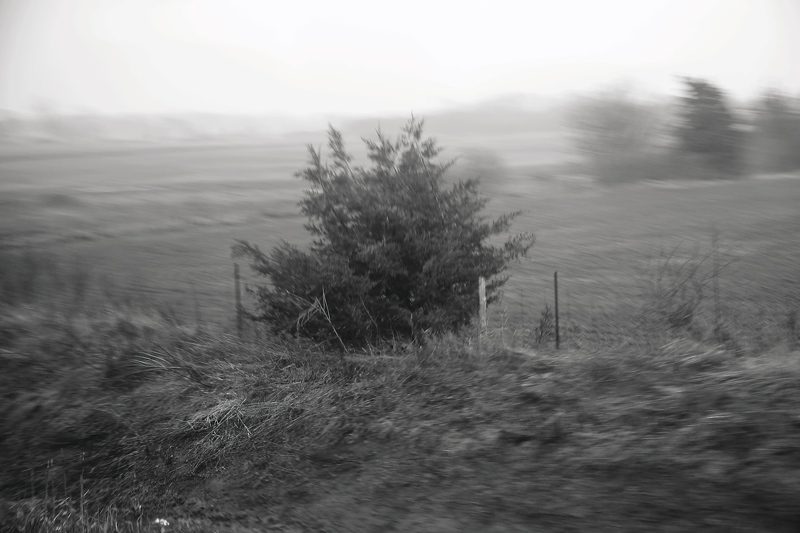Patrick Mikhail Gallery, Montreal
March 20 to April 28, 2015
By Adam Barbu
In recent years, Ottawa-based artist Andrew Wright has produced numerous bodies of work that propose new readings on the ontology of the image. In particular, Wright’s exhibition at Patrick Mikhail’s new Montreal gallery space, titled Untitled Photographic Pictures, presents a series of large-scale photographic works and two mixed-media sculptural works that underscore the artist’s continued effort to use classical motifs and methods as a means to access broader questions concerning the medium of photography itself.
In this series of photographs, Wright opens up a rich interpretive space by taking the motif of the empty landscape and making it strange. Each photograph is a direct-from-camera snapshot taken through the window of a moving train. As he passes by the landscape, Wright makes a deliberate jerking motion with the camera that causes the otherwise clear, focused image to be interrupted. This destabilizing movement leaves the viewer continually distanced from the “original” landscape. Within the confines of the gallery space, these visual disturbances, or “knots,” are immediately apparent to the viewer; yet, the images, captured in a moment between documentation and abstraction, are not clearly revealed. At first glance – without consulting the exhibition text, for example – one might assume that the artist has digitally edited these images to arrive at an ideal formal state. However, the critical viewer will not read these photographs simply as either completely “untouched” or “altered,” but will consider the ways in which the photographic impulse itself is always already held in a tension between composition and incident. The queerness of Wright’s arrival of the image is related to his broader interest in shifting the conversation away from representation or iconographic content and toward process itself.
Wright demonstrates a kind of romantic staging of the photograph that blends realism and artifice. Furthermore, a certain kind of playfulness motivates his decision to raise the seemingly commonplace disposable snapshot to the scale of a history painting. On the one hand, this gesture seems to be a comment on our cultural understanding of what constitutes a valuable image; on the other, the scale and pristine formalism of these works can be seen as a point from which to call attention to the objecthood of both the photograph and the camera. Of course, these photographs “look” toward the landscape, but when we consider the performative act of taking the snapshot, they speak to a far more rudimentary and fundamental set of questions about the medium itself. Here, Wright’s series evokes neither an outright minimalist nor an expressionistic practice, but a kind of intimate, self-reflexive conceptualism.
Elsewhere in the gallery space, Wright presents two separate mixed-media sculptural works that focus on the materiality of the camera itself. With Disused Twin Brownie Hawkeye Cameras, for example, Wright has cast two outdated Kodak Brownie cameras in silver and stacked them in a custom plinth. At first glance, this work seems to comment on the idea of the readymade by taking an obsolete and inexpensive piece of technology and turning it into a valuable commodity object. But taken further, we must also consider that in this silver casting, the camera and the lens are completely obstructed and shut off from the world, no longer an object to view from, becoming instead an object to be viewed. Looking more closely at the work, we also find that the cubic structure that houses the object is in fact a closed circuit of mirrors, reflecting inward and producing an infinite series of repetitions of the image of the silver camera. With the sculpture trapped within this impenetrable hall of mirrors, Wright stages a subtle role reversal of the camera, as it becomes a closed circuit of information – a sort of double negative of visuality.
Untitled Photographic Pictures thoughtfully articulates a sense of care for the image that cuts across Wright’s œuvre. To reflect back on and emphasize the title of the exhibition, Wright is not simply taking photographs as a detached spectator, but – an important distinction – creating pictures by intentionally blending old and new photographic technologies and processes. In this interstitial space between realism and artifice, and between the commonplace and the formal, Untitled Photographic Pictures seems to suggest a slowing down of our now-regularized hyper-exchange and -consumption of images through various Internet technologies. What begins as a search for meaning within the photographic image itself is at the same time a question about what sharpened sensitivity or awareness will carry over to the viewer as she or he leaves the gallery space.
Adam Barbu is an independent writer and curator currently living in Ottawa. He has organized contemporary art exhibitions nationally and internationally that explore themes of cultural memory, the politics of spectatorship, and alternative modes of public engagement. His current critical research focuses on queer theory, “post-AIDS” discourses, and early minimalist art.



